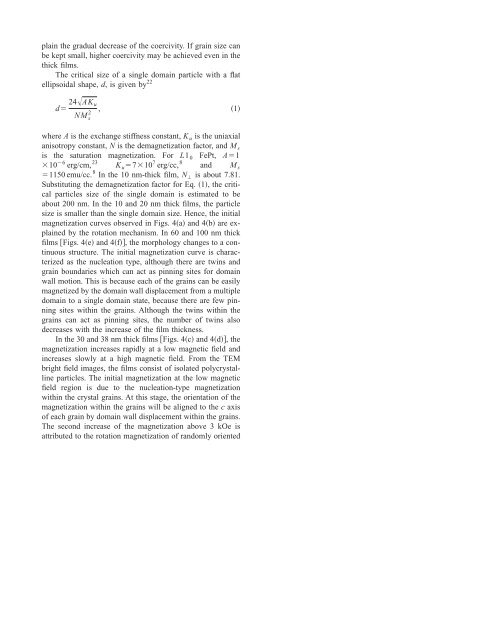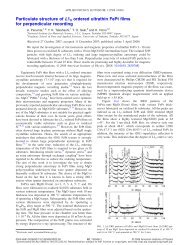plain the gradual decrease <strong>of</strong> the coercivity. If grain size canbe kept small, higher coercivity may be achieved even in thethick films.The critical size <strong>of</strong> a single domain particle with a flatellipsoidal shape, d, is given by 22d 24AK u, 12NM swhere A is the exchange stiffness constant, K u is the uniaxialanisotropy constant, N is the demagnetization factor, <strong>and</strong> M sis the saturation magnetization. For L1 0 <strong><strong>Fe</strong>Pt</strong>, A110 6 erg/cm, 23 K u 710 7 erg/cc, 8 <strong>and</strong> M s1150 emu/cc. 8 In the 10 nm-thick film, N is about 7.81.Substituting the demagnetization factor for Eq. 1, the criticalparticles size <strong>of</strong> the single domain is estimated to beabout 200 nm. In the 10 <strong>and</strong> 20 nm thick films, the particlesize is smaller than the single domain size. Hence, the initialmagnetization curves observed in Figs. 4a <strong>and</strong> 4b are explainedby the rotation mechanism. In 60 <strong>and</strong> 100 nm thickfilms Figs. 4e <strong>and</strong> 4f, the morphology changes to a continuousstructure. The initial magnetization curve is characterizedas the nucleation type, although there are twins <strong>and</strong>grain boundaries which can act as pinning sites for domainwall motion. This is because each <strong>of</strong> the grains can be easilymagnetized by the domain wall displacement from a multipledomain to a single domain state, because there are few pinningsites within the grains. Although the twins within thegrains can act as pinning sites, the number <strong>of</strong> twins alsodecreases with the increase <strong>of</strong> the film thickness.In the 30 <strong>and</strong> 38 nm thick films Figs. 4c <strong>and</strong> 4d, themagnetization increases rapidly at a low <strong>magnetic</strong> field <strong>and</strong>increases slowly at a high <strong>magnetic</strong> field. From the TEMbright field images, the films consist <strong>of</strong> isolated polycrystallineparticles. The initial magnetization at the low <strong>magnetic</strong>field region is due to the nucleation-type magnetizationwithin the crystal grains. At this stage, the orientation <strong>of</strong> themagnetization within the grains will be aligned to the c axis<strong>of</strong> each grain by domain wall displacement within the grains.The second increase <strong>of</strong> the magnetization above 3 kOe isattributed to the rotation magnetization <strong>of</strong> r<strong>and</strong>omly oriented
J. Appl. Phys., Vol. 96, No. 1, 1 July 2004 Takahashi et al.4811 The film morphology changes from a particulate structureto a continuous structure with increasing film thickness.2 The 10 nm thick <strong><strong>Fe</strong>Pt</strong> film shows a high H c such as 23kOe. The H c decreases gradually with an increase in thefilm thickness, not showing a drastic decrease like that inthe single crystalline <strong><strong>Fe</strong>Pt</strong> films deposited on a MgO001 single crystal substrate. High coercivity in thepolycrystalline film is due to the <strong>magnetic</strong> domain pinningat the grain boundaries <strong>and</strong> the twins in the grains.3 Exchange coupled <strong>Fe</strong>/<strong><strong>Fe</strong>Pt</strong> bilayer thin films showed improvedenergy products <strong>of</strong> (BH) max 16.9 MGOe.ACKNOWLEDGMENTSThis work was partly supported by the Special CoordinationFunds for Promoting Science <strong>and</strong> Technology on‘‘Nanohetero Metallic Materials’’ from the Ministry <strong>of</strong> Education,Culture, Sports, Science <strong>and</strong> Technology. One <strong>of</strong> theauthors Y.K.T. acknowledges the Japan Science PromotionSociety for a JSPS fellowship.1 R. Coehoorn, D. B. de Mooiji, <strong>and</strong> C. de Waard, J. Magn. Magn. Mater.80, 1011989.2 E. F. Kneller <strong>and</strong> R. Hawig, IEEE Trans. Magn. 27, 3588 1991.3 R. Fischer, T. Schrefl, H. Kronmüller, <strong>and</strong> J. Filder, J. Magn. Magn. Mater.153, 351996.4 S. Hirosawa, H. Kanekiyo, <strong>and</strong> M. Uehara, J. Appl. Phys. 73, 64881993.5 D. C. Crew, J. Kim, L. H. Lewis, <strong>and</strong> K. Barmak, J. Magn. Magn. Mater.233, 2572001.6 J. P. Liu, C. P. Luo, Y. Liu, <strong>and</strong> D. J. Sellmyer, Appl. Phys. Lett. 72, 4831998.7 R. F. Sabiryanov <strong>and</strong> S. S. Jaswal, J. Magn. Magn. Mater. 177–181, 9891998.8 O. A. Ivanov, L. V. Solina, V. A. Demshima, <strong>and</strong> L. M. Maget, Phys. Met.Metallogr. 35, 811973.9 T. Shima, T. Moriguchi, S. Mitani, <strong>and</strong> K. Takanashi, Appl. Phys. Lett. 80,288 2001.10 Y. K. Takahashi, M. Ohnuma, <strong>and</strong> K. Hono, Jpn. J. Appl. Phys., Part 2 40,L1367 2001.11 M. Watanabe <strong>and</strong> M. Homma, Jpn. J. Appl. Phys., Part 1 35, 12641996.12 M. H. Hong, K. Hono, <strong>and</strong> M. Watanabe, J. Appl. Phys. 84, 44031998.13 Y. Ide, T. Goto, K. Kikuchi, K. Watanabe, J. Onagawa, H. Yoshida, <strong>and</strong> J.M. Cadogan, J. Magn. Magn. Mater. 177–181, 12451998.14 T. Shima, K. Takanashi, Y. K. Takahashi, <strong>and</strong> K. Hono, Appl. Phys. Lett.81, 1050 2002.15 S. Okamoto, O. Kitakami, N. Kikuchi, T. Miyazaki, Y. Shimada, <strong>and</strong> Y. K.Takahashi, Phys. Rev. B 67, 094422 2003.16 C. Kuo, P. C. Kuo, <strong>and</strong> H. Wu, J. Appl. Phys. 85, 2264 1999.17 P. T. L. Minh, N. P. Thuy, N. D. Van, <strong>and</strong> N. T. N. Chan, J. Magn. Magn.Mater. 239, 335 2002.18 Y. Tanaka, N. Kimura, K. Hono, K. Yasuda, <strong>and</strong> T. Sakurai, J. Magn.Magn. Mater. 170, 289 1997.19 M. H. Hong, K. Hono, <strong>and</strong> M. Watanabe, J. Appl. Phys. 84, 44031998.20 T. Shima, T. Seki, K. Takanashi, Y. K. Takahashi, <strong>and</strong> K. Hono, ProceedingsInternational Conference on Magnetism, Rome, Italy, 2003.21 R. C. O’H<strong>and</strong>ley, Modern Magnetic Materials Principles <strong>and</strong> ApplicationsWiley-Interscience, New York.22 G. Q. Li, H. Takahoshi, H. Ito, H. Saito, S. Ishio, T. Shima, <strong>and</strong> K.Takanashi, J. Appl. Phys. 94, 5672 2003.23 S. Okamoto, N. Kikuchi, O. Kitakami, T. Miyazaki, Y. Shimada, <strong>and</strong> K.Fukamichi, Phys. Rev. B 66, 024413 2002.Downloaded 26 Jun 2004 to 144.213.253.14. Redistribution subject to AIP license or copyright, see http://jap.aip.org/jap/copyright.jsp






